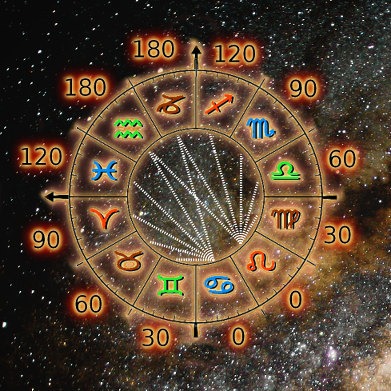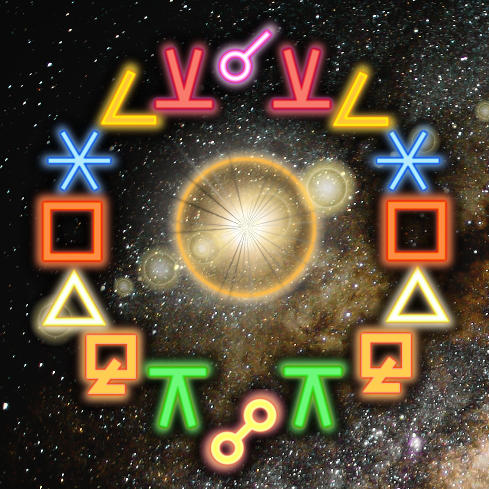The Key Astrological Aspects: presentation
If the Planets constitute functions or energies, then the Aspects that connect them can teach us about the interactions that unite them, as well as the relationships and dialogue that are established between these energies, which may be harmonious or dissonant to varying degrees, tempering or emphasizing them.
Technically the Aspects are established based on the degrees separating the planets or points; we allow for a certain number of degrees around the exact degree measurement and this is called an orb (they are listed below and may fluctuate, see the chapter on them), here are their main characteristics:
- Conjunction, 0° precise measure, 10° orb,
symbolizing “Unit”, major aspect, neutral. - Semi-sextile, 30° precise measure, 2° orb,
symbolizing “Integration, disruption of unity, germ of creation”, minor discordant aspect. - Semi-square, 45° precise measure, 3° orb,
symbolizing “Hesitations, tension”, minor discordant aspect. - Sextile, 60° precise measure, 6° orb,
symbolizing “Harmony, cohesion, complementarity”, harmonious, minor aspect. - Square, 90° precise measure, 8° orb,
symbolizing “Action”, major discordant aspect. - Trine, 120° precise measure, 8° orb,
symbolizing “Harmonious expansion”, major harmonious aspect. - Sesquisquare, 135° precise measure, 3° orb,
symbolizing “Confrontation and freedom”, minor discordant aspect. - Quincunx, 150° precise measure, 3° orb,
symbolizing “Mental alertness, internal tension”, minor discordant aspect. - Opposition, 180° precise measure, 10° orb,
symbolizing “Antagonism and structuring”, major discordant aspect.
Other secondary aspects exist: Biquintile (144°), Quintile (72°), Novile (40°), Binovile (80°), Semi-Quintile or Decile (36°) and Tridecile (108°). Some aspects also sometimes come out of a less natural division of the circle, like the Septile (360° divided by 7 giving 51.42)… They can become significant if they are strongly represented in the overall planetary arrangement, and they are often associated with karmic notions, a manifestation of karma (some sort of “debt” or reward).
Aspects indicate the “dynamics” of one’s birth chart; they position the birth chart in relation to the notion of “active cycles” and therefore pertain to evolution (see the amazing book “Astrological Aspects – A Process-Oriented Approach” by Dane Rudhyar).
Planetary energies are constantly moving and their interactions change accordingly. Their relationships evolve, the Aspects that they form “impart vibrations to one’s birth chart”, and Aspects allow for the establishment of the dominant features of the birth chart.
They are not to be confused with the Astrological Houses, which represent the relevant areas of life, nor with the Zodiac Signs, which symbolize the archetypes of applied human consciousness.
In absolute terms, Aspects should not be interpreted in isolation , but instead all of their interactions should be taken into account in a chart, with all Aspects at once, as they impact each other.
One should not focus on one Harmonious or discordant Aspect or another without analyzing the full picture.
The orbs of Astrological Aspects
The closer an aspect is to the exact measurement in degrees, the stronger it is. All astrologers apply their own “recipes” to calculate their orbs according to whether they are analyzing a birth chart, Transits, Synastry, etc.
One can also consider the aspects as being related to Signs and Astrological Elements, without really taking into account the measurements in degrees, so “zones” would be considered instead of “points”: see also “Planetary Framing Technique”.
In general, one uses broad orbs for “bringing a birth chart to life” and fine orbs when looking for precision (for example in Progressions). Wider orbs are thus tolerated for the luminaries (Sun, Moon), the Ascendant and the Midheaven.
An orb also depends on whether it is for a minor or major aspect: major aspects have larger orbs because of their importance.
Finally, the more an aspect forms an acute angle with few degrees, the finer its orb is because there are other notable aspects very close to it on which it could encroach if it had a larger orb (for example the Semi-sextile is 30°, and the Decile is noteworthy at 36°).
Astrological Aspects: a notion of planetary cycles
The notion of a “cycle” in astrological terms is fundamental and should be involved when considering Aspects.
By observing the cycles of each planet and each Aspect, we see the overall processes at work in the chart we are analyzing, in each planetary transit, not simply a frozen vision of one moment in time.
An astrological cycle can in the most basic sense be broken down by the Cardinal cross into 4 positions, and the faster planet brings action, while the slower planet is the backdrop:
- The increasing or growing phase (1/4 cycle, waxing phase): the Separative Conjunction, then the increasing Square
- The culmination (the peak): the Half Cycle Opposition
- The decreasing or declining phase (3/4 cycle, waning phase): the decreasing Square, the Applying Conjunction
In my various descriptions of the Astrological Aspects presented here, I’d like to emphasize the principles of traditional astrology in the “world horoscope” of antiquity (see the book “Harmonices Mundi”, by Johannes Kepler); I consider the conjunction of Moon and Sun as a symbolic base, represented in the zodiac by Cancer and Leo, respectively. The other aspects unfold on either side (growing and declining), this is what corresponds the most accurately to my understanding, the planetary aspects being cycles of relationships that are independent of any point in space.
Some astrologers take as a symbolic starting point the 0° vernal point of Aries, which is a point in the zodiac that symbolizes the astrological new year, the spring equinox.

Applying aspects, exact aspects, and separating aspects
This notion of “separating” (departing/inclining) and “applying” (approaching/declining) can be applied to all aspects, as it simply indicates the precise phase of the aspect:
- Applying: the fast planet, in its declining phase, returns to the Conjunction
- Separating: the fast planet overtakes the slow planet and initiates the inclining/growing phase
This cycle describes each phase as a necessary period of evolution, each phase of the cycle is a passage that is part of our constant individual development.
At the end of a cycle, a new cycle can start again, and the Conjunction marks both the beginning and the end.
The phases, inclining and declining, are complementary in terms of evolution, since they complete each other in the logical succession of the cycle, but they are also antagonistic in the sense that they imply inverse movement: they go in opposite directions.
Extraversion, introversion, symbolic centrifugal/centripetal balance.
The decreasing phase will have the same main aspects as the increasing phase but in the opposite direction (for more clarity I prefer to note them in increasing phase degree measurements) : Opposition (180°), Quincunx (210°), Trine (240°), Square (270°), Sextile (300°), Semi-square (315°), Semi-sextile (330°), New Conjunction (360°-0°).
Although bearing the same name in both phases, the Aspects do not have exactly the same meaning: an “increasing square” and a “decreasing square”, for example, will not have the same meaning.
In an astrological cycle, we find all the symbolism of birth, growth, full life and maturity, then decline and finally death/rebirth.
Depending on the Planets involved, the cycle will impact our personal character (Sun, Moon, Mercury, Venus, Mars), social character (Jupiter, Saturn) or transpersonal character (Uranus, Neptune, Pluto).
It should be noted that depending on the planetary combinations involved in the cycle we obtain different nuances in the relationships between these domains.
For example, a Moon-Saturn cycle will imply identity, a Mars-Pluto cycle will initiate social transformation, etc…
Moreover, some planets go better together than others! In fact, some planets are not experienced in the same way for a man as for a woman… These various “affinities” or “hostilities” will combine with Aspects.
Dissociate Aspects
All aspects must be analyzed not only based on their angular ratio, but also based on their Astrological Elements (Fire, Earth, Air, Water).
The accuracy of the aspect in degree indicates the strength of the aspect (wide orb = attenuated strength, exact measurement = reinforced aspect).
But with orbs, it is possible that the nature of the aspect’s element will be totally modified.
Depending on whether an aspect is formed between 2 planets in the same element versus in different elements (signs), the aspect will be attenuated, reinforced, or otherwise modified.
The character of the elements will define the nature of the the encounter between the Planets in terms of how harmonious it is.
For example, a Conjunction can take place in 2 different signs, in which case it will tend towards a Semi-sextile aspect.
The same goes for an Opposition that does not involve similar signs of identical polarity involving complementary elements: it will tend towards the tension of a Quincunx.
For a Trine, which always links together signs of the same element, it will in this case tend to be more like a Square or a Quincunx.
A Square, which always connects signs of the same mode, of different polarities and of different dissonant elements, will tend towards a Sextile or a Trine…
These modifications, which may seem insignificant, actually greatly upset the fundamental nature of the aspect.
The great importance of the Astrological Elements should not be underestimated.
The concept of “Dissociate Aspects” indicates this change of element.
Planets without aspects: the Singleton
Unaspected Planets are those planets that form no noticeable aspect with other planets.
Contrary to what one might think, a planet being unaspected actually acts as a type of aspect.
See the notions of emptiness in astrology.
Some planets are better adapted than others to be unaspected, like Mars or Saturn. Others need it more, like Mercury, the Moon, and Jupiter, to express the full range of their deeper functions, in particular their social, emotional, and receptive functions.
A planet is often enriched by the aspects it forms and exhibits, even by aspects of tension.
Being aspect-less will tend to give too much “free course” to the forces of the planet in question… for better or for worse! This is especially true for strong planets, transpersonal planets, etc. See my article on the singleton.
The astrologer’s mission on the Planet Aspects
The planetary cycles in astrology represent one’s individual, personal, and even spiritual evolution, and in my opinion a good astrologer must analyze the cycles over time and not simply take stock of the configuration of “Aspects in Signs and Houses”.
Good astrological advisors must first of all make all of the people who come to them for consultations understand the importance of them fulfilling the cycles that affect them; they will thus realize as best they can all of the potential that resides in their birth chart, no matter the obstacles that may stand in the way.
It is often helpful, for example, in the case of a Square or an Opposition that poses a problem in terms of being integrated into a birth chart, to go back in time and analyze the chart from the day of the Conjunction in question! You can learn a lot with this technique and get good advice from it…
Situating Aspects in the context of their cycles is a gold mine of philosophical, psychological, and astrological thought and reflection; this is where we get at the heart of the difficulty involved in providing a good interpretation.
